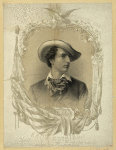Posts Tagged ‘Know Nothings’
New Acquisition: Nativism and Slavery: The Northern Know Nothings & the Politics of the 1850’s
My copy of Tyler Anbinder’s Nativism and Slavery: The Northern Know Nothings & the Politics of the 1850’s finally arrived yesterday. One of my readers recommended it as one of the best resources on the Know Nothings Party which I’ve just finished a series of posts on. Can’t wait to dig in.
ISBN13: 9780195089226
ISBN10: 0195089227
Paper, 352 pages
Oxford University Press
Published: May, 1994
Winner of the Avery O. Craven Award of the Organization of American Historians
New York Times 1992 Notable Book of the Year
Chosen by The Gustavus Myers Center as a 1992 Outstanding Book on Human Rights in the United States Outstanding Book on Human Rights
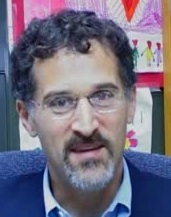 Dr. Anbinder is chair of the Department of History at The George Washington University. You can view his complete C.V. here.
Dr. Anbinder is chair of the Department of History at The George Washington University. You can view his complete C.V. here.
On Know Nothings and Secret Societies – 8
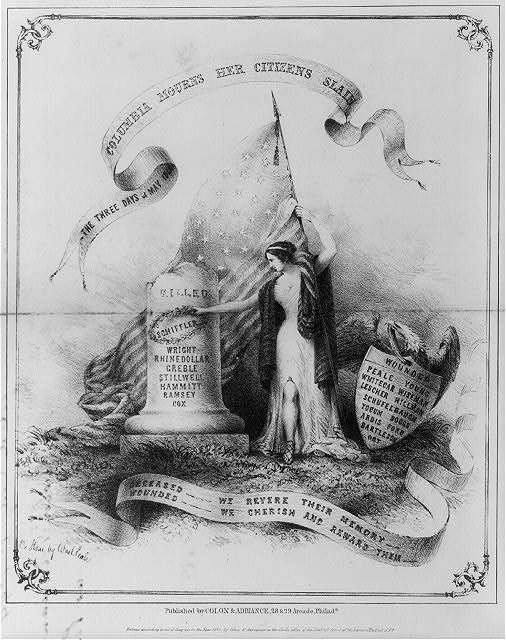
The three days of May 1844. Columbia mourns her citizens slain. Source: Library of Congress
Few would argue that a resurgence of nativism in the mid-19th century had a rational footing. It was, rather, “a nonrational response to contemporary problems” in “an age of social upheaval, an age of deprivation, stress, and imminent disaster.”
The nation was not facing civil war because of immigration from Ireland and Germany. The dislocations of urban-industrial growth were not produced by the newcomers, more victims than villains in this story. Attacking the Irish would not resolve the dilemma of sectional strife. Striking out at the aliens would not bring an end to socioeconomic changes or even the illusion of stability.
But embracing an antialien movement would allow frustrated nativists a sense of “escape from the central problems of their time. Unwilling to accept the dark side of their American experience—the wages of slavery, the stresses of a competitive culture, the crisis of community—they struck out at the most vulnerable group within their midst.” Thus Bennett posits, “the Know Nothing movement and the great appeal of nativism are found in concerns about immigration and historic fears of Catholicism.”
Many nativists thought the solution to the growing turmoil was to return to that which was familiar in the nation’s past, waging battle against an invading alien threat.
Americanists constructed a polarized world in which the enemy (now Catholic Irish and Germans) was an alien intruder and they were the “chosen people.”
In the end, Bennett asserts, the membership of the American Party would discover that “the issues over which they differed were as important as the religious, ethnic, and political bonds that united them.” Even though they achieved considerable early success as a party, they had not found a way to handle the great divisive issue of the day, slavery.
David H. Bennett, The Party Of Fear: The American Far Right from Nativism to the Militia Movement , (Chapel Hill, NC: University of North Carolina Press, 1988), 94, 103, 119.
About the image.
A memorial to nativist casualties of the violent clashes occurring between anti-foreigner “Native Americans” and Irish-American Catholics in Kensington, Philadelphia, May 6 through 8, 1844. The female figure of Columbia holds a large, billowing American flag near a broken column on which she places a wreath. On the column are the names of those Native Americans killed during the attacks on Catholic homes and institutions. At the top of the list, circled by Columbia’s wreath, is the name of George Schiffler, the first and most famous of the nativist martyrs. Other names inscribed on the column are: Wright, Rhinedollar, Greble, Stillwell, Hammitt, Ramsey, and Cox. To the right of Columbia is an American eagle supporting a shield with the names of the wounded, including: Peale (the artist?), Whitecar, Lescher, Young, Wiseman, Willman, Schufelbaugh, Yocum, Ardis, Boggs, Ford, Bartleson, and Ort. Above the figure floats a streamer with the print’s title. Below a similar banner reads “Deceased—-We Revere Their Memory—Wounded—We Cherish And Reward Them—.”
Medium: lithograph on wove paper
Published by Colon & Adriance, 28 & 29 Arcade, 1844.
Library of Congress Call Number: LOT 10615-34 [item] [P&P]
On Know Nothings and Secret Societies – 6
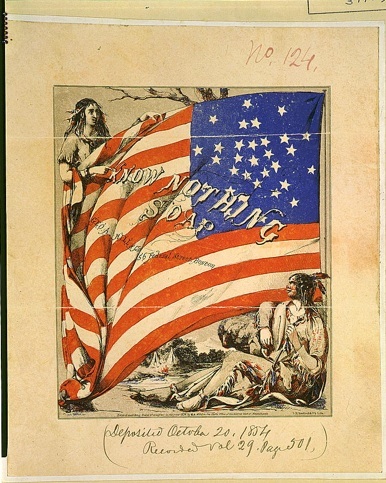
Know-Nothing Soap, Library of Congress, Repository: Library of Congress Prints and Photographs Division Washington, D.C. 20540 USA http://hdl.loc.gov/loc.pnp/pp.print
With the election of 1854, a stunning demonstration of the Know Nothings’ magnetic appeal, nativism became a new American rage.
Know Nothing candy, Know Nothing tea, and Know Nothing toothpicks were marketed, buses and stagecoaches received the charmed name, the clipper ship Know Nothing was launched in New York. Books appeared with “KN” on the cover, “Know Nothing” poems found easy publication, and the widely circulated Know Nothing Almanac or True American’s Manual was issued. The Almanac had schedules for sunset and moon phases mixed with a potpourri of nativist polemics, including stories of Catholic machinations in Ireland, statistics of foreigners in the almshouses and charity hospitals, as well as warnings of every kind of alien conspiracy. (1)
What had humble beginnings, as a fraternity, was now the American party. “Those in the movement remained proud of the secret order at the heart of the political organization.” (1)
——
(1) David H. Bennett, The Party of Fear: From Nativist Movements to the New Right in American History, 115.
About the image: An illustrated advertising label for soap manufactured in Boston, interesting for its imagery and allusion to the popular “Know Nothing” or nativist movement. In the foreground are two American Indians, emblematic of the movement’s prejudice against the foreign-born. In the lower right is a seated brave, leaning against a rock and holding a pipe. Above him a large American flag, with thirty-one stars, unfurls across the main picture area. The flag is supported in the upper left corner by an Indian woman, who points to the words “Know Nothing Soap” emblazoned on it. In the background is a landscape with tepees and a campfire on the bank of a stream.
Medium: 1 print : lithograph printed in red, grey, blue, and black on coated paper ; 15.2 x 12.6 cm. (image)
Created/Published:1854.
On Know Nothings and Secret Societies – 5
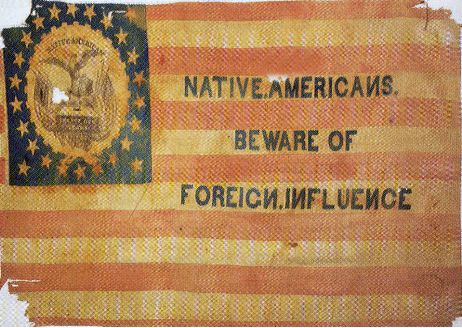
Flag of the Know Nothing Party
Historian James McPherson points out that the membership in the Know Nothings was “drawn primarily from young men in white-collar and skilled blue-collar occupations. A good many of them were new voters. One analysis showed that men in their twenties were twice as likely to vote Know Nothing as men over thirty.” (1)
Their leaders were also “new men” in politics who reflected the social backgrounds of their constituency. In Pittsburg, more than half of the Know-Nothing leaders were under thirty-five and nearly half were artisans and clerks. Know Nothings elected to the Massachusetts legislature in 1854 consisted mainly of skilled workers, rural clergymen, and clerks in various enterprises. Maryland’s leaders were younger and less affluent than their Democratic counterparts.” (1)
For more information on the Know Nothing Party in Massachusetts, see the Massachusetts Historical Society here.
(1) Battle Cry of Freedom: The Civil War Era (Oxford History of the United States), (New York: Oxford Press, 1988), 135-136.
Battle Cry of Freedom: The Civil War Era (Oxford History of the United States), (New York: Oxford Press, 1988), 135-136.
On Know Nothings and Secret Societies – 4
Historian David H. Bennett contends, “Only in extraordinary times could nativism shape the policies of and give its name to a major party. Such was the situation from I852 to 1854” as regards the Know Nothing Party.
Men of political prominence began to join. In several New England states, the Know Nothings became a formidable force by appealing to the
antislavery wing of the former Whig party. But throughout much of the South, displaced Whigs looked to nativism to protect their proslavery institutions. Passage of the Kansas-Nebraska Act accelerated the movement’s growth; with talk of “bleeding Kansas” on every lip, converts flocked in at the rate of five thousand per week in 1854. Men with promising futures began to seek entry. In the South there were John Bell (right), to be presidential candidate of the Constitutional Union party in 1860, and John J. Crittenden, senior senator from Kentucky, author of the compromise plan to solve the sectional struggle in the months before the outbreak of war. Henry Winter Davis, powerful Whig from Baltimore, and Andrew Jackson Donelson became Know Nothings. In the North, Nathaniel P. Banks and Jerome C. Smith, who would ride the antialien tide to prominence, one as Speaker of the House of Representatives and the other as mayor of Boston, were initiated. Henry Wilson, vice-president of the United States two decades later, Edward Everett, a future secretary of state, and Edward Bates, Lincoln’s attorney general, came to the new party. After considering the triumphant run of victories for the Know Nothings in the fall elections, even Millard Fillmore joined, taking the secret rites of the Star Spangled Banner in his own home in late winter.
David H. Bennett, The Party of Fear: From Nativist Movements to the New Right in American History, 114.
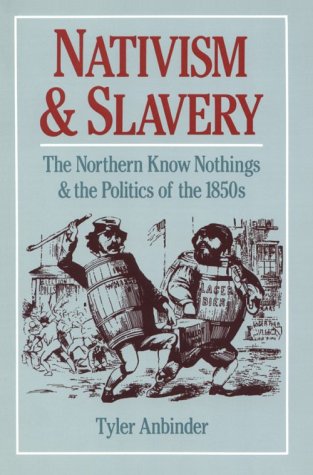
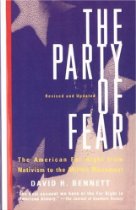
 In the spring of 1850, another nativist fraternity, The Order of the Star Spangled Banner (OSSB) was founded in New York City by Charles B. Allen, a thirty-four-year-old commercial agent born and educated in Massachusetts. (1) At first a simple “local fellowship numbering no more than three dozen men, there was little to distinguish their order from many other ‘patriotic’ groups, little reason for anyone to expect that it would be the core of a major political party, the greatest achievement of nativism in America.” (1) By 1852, it began to grow quickly and leaders of the Order of United Americans (OUA) took notice. Many of their membership joined and the OSSB membership swelled “from under fifty to a thousand in three months.” (1) Later that year, the two organizations joined under the leadership of James Barker and, with astute organizational skill, hundreds of lodges were formed “all over the country with an estimated membership ranging up to a million or more.” (2) Those who joined promised, as a part of secret rituals, to “vote for no one except native-born Protestants for public office” and “the Order endorsed certain candidates or nominated its own” in secret councils. Because their rules required them to say they “knew nothing” about the organization if asked, the movement became known as the “Know Nothings” (3)
In the spring of 1850, another nativist fraternity, The Order of the Star Spangled Banner (OSSB) was founded in New York City by Charles B. Allen, a thirty-four-year-old commercial agent born and educated in Massachusetts. (1) At first a simple “local fellowship numbering no more than three dozen men, there was little to distinguish their order from many other ‘patriotic’ groups, little reason for anyone to expect that it would be the core of a major political party, the greatest achievement of nativism in America.” (1) By 1852, it began to grow quickly and leaders of the Order of United Americans (OUA) took notice. Many of their membership joined and the OSSB membership swelled “from under fifty to a thousand in three months.” (1) Later that year, the two organizations joined under the leadership of James Barker and, with astute organizational skill, hundreds of lodges were formed “all over the country with an estimated membership ranging up to a million or more.” (2) Those who joined promised, as a part of secret rituals, to “vote for no one except native-born Protestants for public office” and “the Order endorsed certain candidates or nominated its own” in secret councils. Because their rules required them to say they “knew nothing” about the organization if asked, the movement became known as the “Know Nothings” (3)
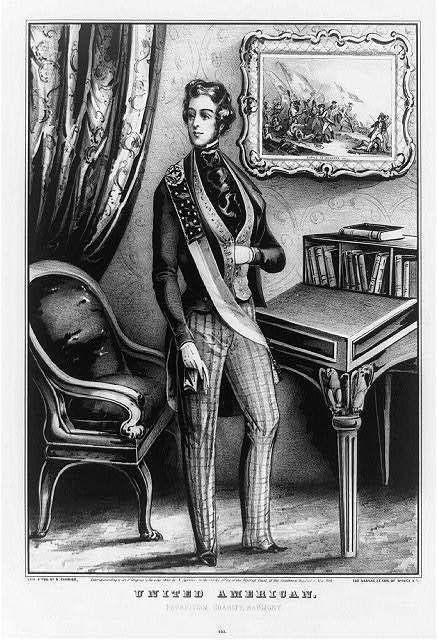 Bits of white paper strewn across a prearranged site announced the meeting of the brotherhood. Held at night, in keeping with the secrecy that shrouded its early years, the sessions of the local chapters of the Order of the Star Spangled Banner were open only to initiates and those about to join them in the ranks. The ritual for admission to the lodge seemed endless. But instead of irritating men tired after a long day’s work, the elaborate raps and special handclasps, the passwords between brothers, and the sentinels sent to escort candidates long known to the membership seemed to heighten the feeling of camaraderie, the sense of special excitement at the dangerous but essential mission they were privileged to share. For they were there to save and cleanse the nation, to preserve for themselves that abstraction which some would later call the American dream.
Bits of white paper strewn across a prearranged site announced the meeting of the brotherhood. Held at night, in keeping with the secrecy that shrouded its early years, the sessions of the local chapters of the Order of the Star Spangled Banner were open only to initiates and those about to join them in the ranks. The ritual for admission to the lodge seemed endless. But instead of irritating men tired after a long day’s work, the elaborate raps and special handclasps, the passwords between brothers, and the sentinels sent to escort candidates long known to the membership seemed to heighten the feeling of camaraderie, the sense of special excitement at the dangerous but essential mission they were privileged to share. For they were there to save and cleanse the nation, to preserve for themselves that abstraction which some would later call the American dream.